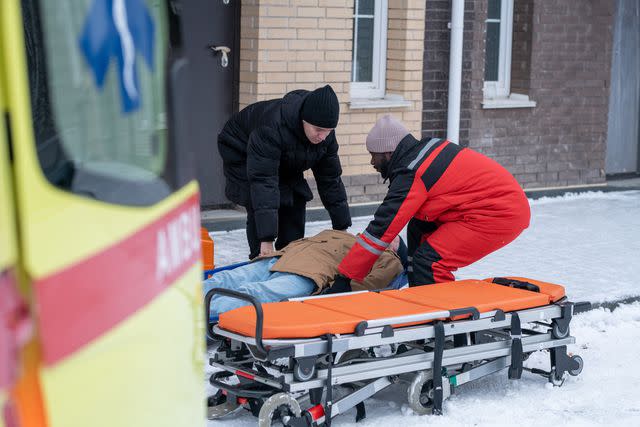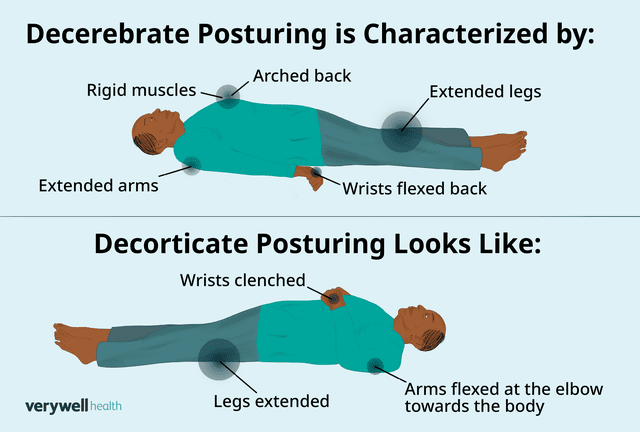Decorticate vs. Decerebrate Posturing: Differences Explained
Reflex Movements in Response to Brain Damage
Medically reviewed by Katrina Carter, DPT
Decorticate and decerebrate posturing are different reflexes that are both signs of severe brain damage. Each of these physical positions involves a pattern of sustained involuntary extension (increased angle that straightens joints) or flexion (a decreased angle that bends the joints) of the neck, torso, arms, and legs that develop in response to damage affecting both sides of the brain.
Generally, decorticate or decerebrate posturing are associated with a very low chance of survival, and neither is verified as better or worse than the other.
This article describes decorticate and decerebrate posturing, the causes, treatments, and what to expect if your loved one is showing these signs.

Pressmaster / Getty Images
Comparing Decorticate vs. Decerebrate Posturing
Typically, decorticate and decerebrate posturing are not compared with each other in a medical setting. Anyone who develops signs of either of these reflexes would be given the same type of medical intervention, depending on the underlying cause.
Additionally, the postures themselves are not dangerous or harmful—they are visible consequences of severe brain damage.

Illustration by Michela Buttignol for Verywell Health
Physical Signs
There are characteristic physical patterns of decorticate and decerebrate posturing. Sometimes, the effects of seizures, drug intoxication, drug withdrawal, or psychiatric conditions can look similar to decorticate or decerebrate postures.
If your loved one has signs of decorticate or decerebrate posture, it’s important for their healthcare providers to diagnose their condition because the treatments for the other conditions that can look similar to reflex posturing is not the same.
Decorticate posturing looks like:
Arms flexed towards the body
Tights fists
Arched or extended neck and back
Legs extended
Feet or knees might be slightly turned inwards towards each other
Decerebrate posturing looks like:
Arms extended
Curled wrists
Legs extended
Ached or extended neck and back
Decerebrate or decorticate posturing develops along with other neurological signs or symptoms. A person experiencing decorticate or decerebrate reflex posturing will also be unresponsive, unable to voluntarily move, and have a neurological diagnosis.
How to Remember the Difference
Decerebrate posture involves extension of the arms, and decorticate posture involves flexing the arms toward the core (center) of the body.
Students who are studying these positions sometimes remember the differences between the two by recalling that the word "decerebrate" contains several letter "E's," which can stand for "extension," while "decorticate" includes the word "core" and involves arm movement toward the core of the body.
Neurological Effects
Decerebrate and decorticate posturing develop as a result of extensive nerve damage in the brain. The nerves in the brain communicate with each other to stimulate and inhibit brain activity.
Extensive brain damage leads to impairment of nerves that promote movement. The imbalance can cause either decerebrate or decorticate posture and often eventually results in brain death.
Causes
Both decorticate and decerebrate posturing are neurological signs of brain damage that can be caused by a variety of medical conditions.
Possible causes of decorticate or decerebrate posturing include:
A large stroke causing edema (swelling and inflammation in and around the brain)
A large brain tumor
Encephalitis (inflammation or infection of the brain tissue)
Drug or alcohol overdose or withdrawal
Hypoxic brain injury (a lack of oxygen to the brain, usually due to heart failure or a heart attack)
Any of these conditions may cause a profound lack of oxygen and glucose in the brain, causing rapid and irreversible degeneration of nerves throughout the brain. This process can lead to swelling, inflammation, and dysfunction of the brain cells—which can produce reflexes such as decerebrate or decorticate posturing.
Location of Brain Damage
In the past, some research had suggested that decorticate or decerebrate posture corresponded to specific regions of brain damage.
However, more detailed information about brain structure has become available with electroencephalogram (EEG) monitoring and neuroimaging. From those tests, it's become clear that the anatomy is complex and that it isn’t possible to locate specific regions of brain involvement as causing decorticate or decerebrate postures.
Severity and Outlook
Generally, decorticate or decerebrate postures are caused by medical conditions that are not reversible. These conditions do not last for a long period of time and are generally associated with impending death.
Medical Interventions to Prevent Decorticate and Decerebrate Posturing
Treatment for the neurological damage that causes decorticate posturing is the same as the treatment for neurological damage that causes decerebrate posturing.
A key feature of treatment is that prevention before these postures develop is more beneficial than interventions that are started after these postures develop. Additionally, treatment typically needs to be adjusted as the condition evolves.
Treatments for preventing decorticate or decerebrate posture includes:
Medication to reduce edema (fluid and swelling in the brain), which may include steroids or diuretics (water pills)
Surgical procedure to remove blood or fluid from around the brain
Placement of a shunt (flexible tube) to continuously remove excess fluid from around the brain
Removal of a brain tumor
Hemicraniectomy, a procedure to temporarily remove a portion of the skull in order to relieve pressure from around the brain
All of these procedures help prevent extreme pressure on the brain, which can cause brain damage that may lead to decerebrate or decorticate posturing.
Role of Physical Therapy
Sometimes, neurological disorders may have effects that are informally described as decerebrate or decorticate. For example, cerebral palsy may cause sustained flexion for extension of the extremities.
Additionally, a stroke may cause a person to have extension (increased angle that straightens joints) or flexion (a decreased angle that bends the joints) of one side of the body. In such conditions, the muscle stiffness or spasms could potentially be treated with physical therapy.
Physical therapy involves active (deliberate) or passive (the therapist moves your muscles for you) movements that can prevent permanent muscle stiffness from developing.
Summary
Decerebrate and decorticate posturing are reflexes that indicate extreme brain damage on both sides of the brain. Neither posture is better or worse than the other, and it is difficult to interpret either as corresponding to specific regions of brain damage.
If a person is at risk of developing to decerebrate or decorate posturing, prevention of the progression of brain damage is crucial. Medical therapies and procedures may help prevent the type of excessive brain damage that could lead to decerebrate and decorticate posturing.
Additionally, certain medical conditions may cause physical signs that appear similar to these postures, and it is important to get an accurate diagnosis and initiate treatment.
If your loved one is experiencing decerebrate or decorticate posturing, you will need to speak with their healthcare providers about their plan of care because these signs can indicate a life-threatening condition with poor chance of survival.
Read the original article on Verywell Health.

